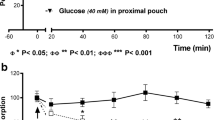Abstract
Distension of an isolated preparation of guinea pig ileum triggers the peristaltic reflex, a characteristic movement of the intestinal walls which generates luminal pressures and clearance of luminal contents. To determine how the reflex responds to properties of luminal contents, we compared the responses triggered by boluses of air, oil, and cellulose to boluses of Krebs' solution. We found that oil and cellulose increased pressures and contraction length and decreased outflow. Cellulose, but not oil, slowed the velocity with which the contraction propagated and increased the delay with which the end point (upstream edge) of the contraction started to propagate after the lead point (downstream edge). Air tended to produce short contraction segments and high velocity. We conclude that bolus properties such as viscosity determine the response that isolated intestinal segments generate to distension. Response patterns are reflected in contraction length, propagation velocity, and other visual parameters that define wall movements.
Similar content being viewed by others
REFERENCES
Trendelenburg F: Physiologische Versuche ber die Dünndarmperistaltik. Arch Exp Pathol Pharmakol 81:55–129, 1917
Bülbring E, Crema A: The release of 5-hydroxytryptamine in relation to pressure exerted on the intestinal mucosa. J Physiol 146:381–407, 1959
Costa M, Furness J: The peristaltic reflex: an analysis of nerve pathways and their pharmacology. Arch Pharmacol 294:47–60, 1976
Foxx-Orenstein AE, Kuemmerle JF, Grider JR: Distinct 5-HT receptors mediate the peristaltic reflex induced by mucosal stimuli in human and guinea pig intestine. Gastroenterology 111:1281–1290, 1996
Waterman SA, Tonini M, Costa M: The role of ascending excitatory and descending inhibitory pathways in peristalsis in the isolated guinea pig intestine. J Physiol (London) 481:223–232, 1994
Hennig GW, Costa M, Chen BN, Brookes SJH: Quantitative analysis of peristalsis in the guinea-pig small intestine using spatio-temporal maps. J Physiol 517:575–590, 1999
Schulze-Delrieu K: Visual parameters define the phase and the load of contractions in isolated guinea pig ileum. Am J Physiol 276, G1417–G1424, 1999
Siegle M, Ehrlein HJ: Neurotensin changes the motor pattern in canine ileum from propulsive to segmenting. Dig Dis Sci 34:1521–1527, 1989
Siegle ML, and Ehrlein HJ: Digestive motor patterns and transit of luminal contents in canine ileum. Am J Physiol 254:G552–G559, 1988
Schulze-Delrieu K: Clearance patterns of the isolated guinea pig duodenum. Gastroenterology 102:849–856, 1992
Friedman G, Wolf BS, Waye JD, Janowitz HD: Correlation of cineradiographic and intraluminae pressure changes in the human duodenum: an analysis of the functional significance of monophasic waves. Gastroenterology 49:37–49, 1965
Gregersen J, and Kassab G: Biomechanics of the gastrointestinal tract. Neurogastroenterol Motil 8:227–297, 1996
Lin HC, Kim BH, Elashoff JD, Doty JE, Gu YG, Meyer JH: Gastric emptying of solid food is most potently inhibited by carbohydrate in the canine distal ileum. Gastroenterology 102:793–801, 1992
Lin HC, Wang L, Wong H: Fat-induced ileal brake in the dog depends on peptide YY. Gastroenterology 110:1491–1495, 1996
Lin HC, Zhao XT, Wang L: Intestinal transit is more potently inhibited by fat in the distal (ileal brake) than in the proximal (jejunal brake) gut. Dig Dis Sci 42:19–25, 1997
Lin HC, Zhao XT, Chu AW, Lin YP, Wang L: Fiber supplemented enteral formula slows intestinal transit by intensifying inhibitory feedback from the distal gut. Am J Clin Nutrition 65:1840–1844, 1997
Rao SSC, Lu C, Schulze-Delrieu K: Duodenum as an immediate brake to gastric outflow: a videofluoroscopic and manometric assessment. Gastroenterology 110:740–747, 1996
Author information
Authors and Affiliations
Rights and permissions
About this article
Cite this article
Larson, M., Schulze, K. Appearance of Peristaltic Reflex in Isolated Guinea Pig Ileum in Response to Boluses of Air, Water, Oil, and Cellulose. Dig Dis Sci 47, 2644–2650 (2002). https://doi.org/10.1023/A:1021080416483
Issue Date:
DOI: https://doi.org/10.1023/A:1021080416483




